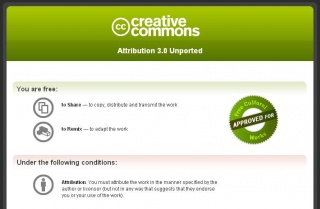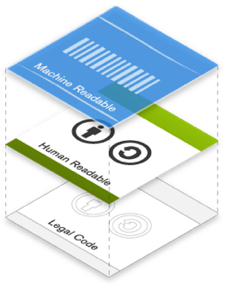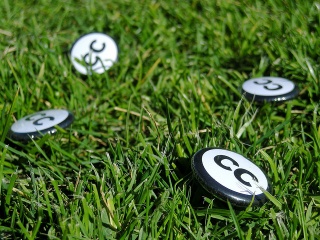Learning in a digital age/LiDA103/Creative Commons/Anatomy
A CC[1] license is composed of three distinct layers.
- Legal Code - Each license begins as a traditional legal tool, in the kind of language and text formats that most lawyers know and love. This is the actual license, which is a detailed legal document.
- Commons Deed - This is a handy reference that summarizes and expresses some of the most important terms and conditions. Think of the Commons Deed as a user-friendly interface to the Legal Code beneath, although the Deed itself is not a license, and its contents are not part of the Legal Code itself.
- Machine-readable version - The final layer of the license design is a “machine-readable” version of the license - a summary of the key freedoms and obligations written into a format that software systems, search engines, and other kinds of technology can understand.
Contents
The Legal Code - valid legal documents
All CC licenses have real legal code, written by and for lawyers, which contains the actual, legally binding terms of the license.At the top of a Commons Deed ("human-readable" version), you will find the word "license" which links to the full legal code for the relevant license. If you are new to CC licenses, we suggest that you scan through one or two of the full licenses to get an idea of what is covered in the legal code. Here are the links to the full licenses:
- Attribution
- Attribution — Share-Alike
- Attribution — No Derivatives
- Attribution — Non-Commercial
- Attribution — Non-Commercial — Share-Alike
- Attribution — Non-Commercial — No Derivatives
The Commons Deed - a "human-readable" version of the license

An example of a CC license deed is shown in the image at right. This deed quickly clarifies that you are free to share the work with anyone, and you are also free to remix the work. “Remix” means that you may alter the work in some way, such as translate it into another language, or add new information. The deed also specifies conditions of use; in this case, you must attribute the work to the original author. If this was your work, people would have to cite you whenever they use your work. The summary deed is not legally binding in and of itself; it is just informational.
You can preview examples of the license deed for each of the CC licenses:
- Attribution
- Attribution — Share-Alike
- Attribution — No Derivatives
- Attribution — Non-Commercial
- Attribution — Non-Commercial — Share-Alike
- Attribution — Non-Commercial — No Derivatives
Version 4.0, the current version of the CC licenses, are called international licenses, for example "Attribution 4.0 International (CC BY 4.0)." Previously the 3.0 and earlier versions of the licenses were translated for the national copyright laws of different countries, a process called "porting the license". Version 4.0 of the licenses can be used around the world, without porting and are backward compatible with earlier versions of the CC licenses.
"Machine-readable" licenses
The machine-readable feature of the licenses makes finding CC-licensed material on the Internet possible. Machine-readable refers to the fact that the license information about your work includes some software code. This software code allows search engines (e.g., Google, Yahoo, etc.) and other software applications to identify materials on the Internet that are licensed using Creative Commons. So if you license your material under Creative Commons, others will be able to easily find and identify your work.
The machine-readable code can be obtained using the CC license chooser tool. Once a license is identified, the tool automatically generates the HTML syntax which can be copied and embedded into web pages on the Internet. This syntax would not be visible to people browsing your web pages but can be read by search engines and in this sense, CC licenses are "machine-readable". Consult your local technical staff for more information on embedding machine-readable code for CC licenses into a web page.
Acknowledgements
Some content on this page was sourced, revised and remixed from:
- http://creativecommons.org/licenses/
- http://wiki.creativecommons.org/FAQ
- CCLearn explanations, OER and CC licenses

